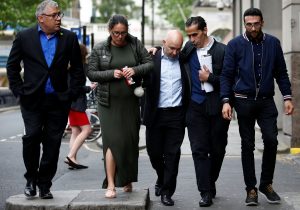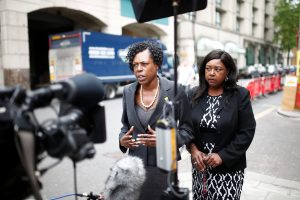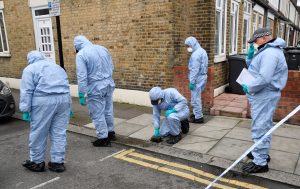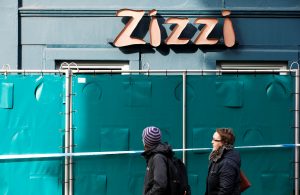
By Fanny Potkin and Polina Ivanova
LONDON (Reuters) – Financial markets braced this week for what could be the Bank of England’s first rate rise in a decade – a step into the unknown for a generation of young traders who started work after 2007 but also for the state-of-the-art technology they use.
After a decade that included a global financial crash, numerous investigations into market collusion and relentless automation, trading floors at banks in London have been transformed in ways not obvious at first glance.
The newest kid on the block is not necessarily the rookie trader with a PhD in physics but the latest computer model or algorithm. How these models will perform under the almost novel circumstances of tightening monetary policy is as much a question as how the human neophytes will react.
Using past market data, assessments of demand, valuation models and even measures of how upbeat news headlines are, computers crunch the numbers, game the scenarios and buy or sell in the blink of an eye.
But shocks such as Brexit have shown that computer-driven trading can end in stampedes, or so-called flash crashes.
“You’ve got to weigh up the strength of the traders and the strength of the algorithms that have been developed and whether they can manage this kind of a process when the rate hike does come in,” said Benjamin Quinlan, CEO of financial services strategy consultancy Quinlan & Associates.
At Citibank’s expansive trading floor in London, the dealing room doesn’t look much different from a decade ago with traders hunched in front of banks of screens, the odd national flag perched on top, and television screens on mute.
But beneath the outward appearance, foreign exchange trading has undergone a seismic shift: more than 90 percent of cash transactions and a growing proportion of derivatives trades in the global $5 trillion a day FX market are done electronically.
So-called smart algos, or fully automated algorithmic trading programs that react to market movements with no human involvement, were virtually non-existent in 2007. Now, almost a third of foreign exchange trades are driven solely by algorithms, according to research firm Aite Group.
“Most of these algorithms haven’t really been tested in a rising interest rate scenario so the next few months will be crucial,” said a portfolio manager at a hedge fund in London.
To be sure, the U.S. Federal Reserve’s first rate rise in a decade in 2015 provided a dry run for this week’s UK decision – but the two economies are in very different positions and the knock-on effects on the wider financial markets of a Bank of England move are hard to predict.
ROOKIES AND ROBOTS
Much has changed since the Bank of England raised rates by 0.25 percent on July 5, 2007 to 5.75 percent. The first iPhone had yet to reach British shores, the country’s TVs ran on analogue signals and Northern Rock bank was alive and well.
Where once lightning decision-making and a calm head in a crisis were at a premium, the bulk of trading today is done by machines and the job of a foreign exchange sales trader is often little more than minding software and fielding client queries.
Itay Tuchman, head of global FX trading at Citi and a 20-year market veteran, said while the bank employs roughly the same number of people in currency trading as over the last few years, fewer are dedicated to business over the phone.
“We have an extensive electronic trading business, powered by our algorithmic market making platform, which is staffed by many people that have maths and science PhDs from various backgrounds,” said Tuchman, who heads trading for Citi’s global developed and emerging currency businesses.
London is the epicenter of those changes with the average daily turnover of foreign exchange trades executed directly over the phone down by a fifth to $566 billion in just three years to 2016, according to the Bank of England.
At Dutch bank ING’s London trading room, Obbe Kok, head of UK financial markets, said the floor now has about 165 people but the bank wants to make it 210 by the end of the year – searching mainly for traders attuned to technological innovations and keen on artificial intelligence.
The proportion of people employed in trading with degrees in mathematics and statistics has increased by a 58 percent over the last 10 years, Emolument, a salary benchmarking site, said.
“What banks have started to do is trade experience for technological skill and with electronic platforms growing, the average age on the floor is a bit younger,” said Adrian Ezra, CEO of financial services recruitment agency Execuzen.
TAPER TANTRUM
The increasing use of technology means traders can gauge the depth of market liquidity at the click of a button or quickly price an option based on volatility – a major change from a few years ago when they had to scour the market discreetly for fear of disclosing their interest to rivals.
Ala’A Saeed, global head of institutional electronic sales and one of the brains behind Citi’s trading platform FX Velocity, said its electronic programs process thousands of trades per minute.
Most of the currency trading models used by banks incorporate variables such as trading ranges, valuation metrics including trade-weighted indexes and trends in demand based on internal client orders to get a sense of which way markets are moving – and the potential impact of a new trade.
Nowadays, the models also incorporate sentiment analysis around news headlines and economic data surprises.
These electronic trading platforms also have years of financial data plugged into them with various kinds of scenario analyses, but one thing they have sometimes appeared unprepared for is a sudden change in policy direction.
Witness the market mayhem exacerbated by trend-following algorithms when Switzerland’s central bank scrapped its currency peg in 2015, or the taper tantrum in 2013 when the U.S. Federal Reserve said it would stop buying bonds.
Or Britain’s vote last year to leave the European Union.
Indeed, the biggest risk for financial markets cited by money managers in a Bank of America Merrill Lynch poll in October was a policy misstep from a major central bank.
EASY CREDIT, LOW VOLATILITY
One concern is that the rise in automation has coincided with a prolonged decline in market volatility as central banks from the United States to Japan have kept interest rates close to zero and spent trillions of dollars dragging long-term borrowing costs lower to try to reboot depressed economies.
While central banks have been careful to get their messages across as they end the years of stimulus, there are concerns about whether quantitative trading models can capture all the qualitative policy shifts.
For example, a growing number of investors expect the Bank of England to raise its benchmark interest rate to 0.5 percent on Nov. 2, and then leave it at that for the foreseeable future.
But futures markets are expecting another rate rise within six to nine months, injecting a new level of risk around interest rate moves and potentially boosting volatility.
Neale Jackson, a portfolio manager at 36 South Capital Advisors, a $750 million volatility hedge fund in London, said young traders have never seen an environment other than central banks supporting markets, and that has fueled risk-taking underpinned by the belief that “big brother has got our backs”.
“The problem these days is that there’s a whole generation of traders who have never seen interest rates, let alone interest rates hikes,” said Kevin Rodgers, a veteran FX trader and the author of “Why Aren’t They Shouting?”, a book about the computer revolution within financial markets.
(Additional reporting by Maiya Keidan and Simon Jessop; writing by Saikat Chatterjee; editing by Mike Dolan and David Clarke)














